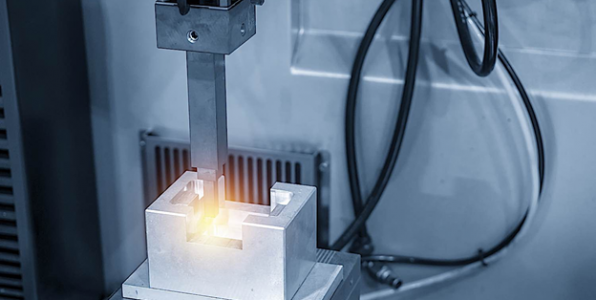How Sinker Electrical Discharge Machining Works

How Sinker Electrical Discharge Machining Works

Sinker electrical discharge machining (SEDM) is the standard or basic method of metal removal. This kind of process is performed by repeating electrical discharges that happen between the workpiece and the cutting tool which is also called an electrode.
Electrical discharge machining services are very important in the production industry. They serve as an integral electro thermal manufacturing process used in improving injection molding – A process that involves the large-scale production of workpieces. Injection molding is commonly utilized in general production procedures when a particular part needs to be created over thousands of times.
Several Injection molding tools are easy to manufacture for businesses through standard machining processes like sinker EDM, and also in circumstances when certain geometric shapes require the utilization of a different EDM process.
Electrical discharge machining is mainly utilized by companies that execute tool and die jobs used in mass production as well as mold-making. It is also very useful in power generation components and aviation. Electrical discharge machining is rapidly being used for prototyping and manufacturing parts in the electronics and aerospace industries, where manufacturing requirements are relatively low and simple. It is an important process when working with tools made of components that are tough to use, or materials that have small angles or odd shapes, complex voids, or contours.
Types of Electrical Discharge Machining
The two main types of EDM are sinker and wire. The sinker is also known as conventional or Ram EDM. The main difference between sinker and wire EDM is the kind of electrode both of them use.
Wire EDM utilizes wire as its electrode medium, just as the name implies. It is an electrothermal manufacturing process in which the outer surface of a workpiece is scraped off with a thin wire to achieve a straight or conical cut in the choice pattern. The operator controlling the process can select different wire diameters that are determined by the cut’s precision and complexity.
In wire EDM, the thin single-core metal wire is utilized with water that is deionized as electricity conductor. Doing this enables the conductor to go through the metal with the use of the heat coming from an electric spark.
Other sections are only utilized by the least conventional EDM which is the sinker. Unlike the wire EDM, the sinker does not out rightly pass through the section. This really sinks the desired shape into detail.
What is Sinker EDM Service?
The sinker electrical discharge machining process uses specially treated electrodes to eject materials in the form of designed and labeled electrodes. During this process, the electrodes are immersed in the component to completely scrape the surface of the material from the top down to the bottom. A well-tuned electric power is used to balance the surface finishing with a higher power setting used in creating rough, quick cuts. The low power setting is used to achieve a very smooth finishing towards the end.
The remaining small metal chips are ejected by a melting and evaporation process continuously washed out by a dielectric field solution.
The sinker electrical discharge machining is widely used to make cavity shapes in tooling and die programs and applications. Some of those applications include plastic injection molds and metal stamping dies. The sinker procedure starts by machining the graphite electrode to turn to the desired “positive” cavity before carefully dipping the electrode into the section. Once this is done, sparks are created on its surface as the procedure shuts the spark space, creating the required distance to the spark.
If you still need more clarification on sinker EDM, this video will be of visual assistance.
How Sinker EDM Works

The real process executed with the sinker electrical discharge machining starts with two metal parts getting immersed in liquid insulin before they are linked to a power source. The power source is then automatically turned on and off according to the requirements outlined on the control. For every time the power is turned on, an electric voltage is generated between the two metals.
The distance existing between both metal parts also plays a role. When the two metal parts are adjusted within an inch of each other, the voltage discharges and this allows the spark to get across. The place where the jot hits is where the iron heats up to melt. Many sparks are sprayed in this process, but not simultaneously and they gradually change the metal pieces to the desired shape in accordance with the electrode’s shape. It takes many sparks to happen in one second before sufficient erosion occurs to produce the desired shape.
Some Common Applications for Sinker EDM
The following are some common applications for sinker electrical discharge machining services:
- Micromachining component and equipment for medical and electronic use
- Manufacture of small, miniature precision parts
- Components for tool and die suitable for precision molds, and specialty machines
Now, these are some of the vital information about the functionality of sinker electrical discharge machining. If you are looking for the benefits of SEDM to everyday usage and application, you can check here: https://en.wikipedia.org/wiki/Electrical_discharge_machining.
Conclusion
With the innovations springing up daily in the electrical and electronics industry, you can rely on SEDMs to produce imprinted shapes that are in metal forms and blind cavities. They achieve this without cutting or compromising the stability or integrity of a work piece.
If you are wondering how to get these services, you can link up with reputable manufacturers for assistance.
Comments are closed